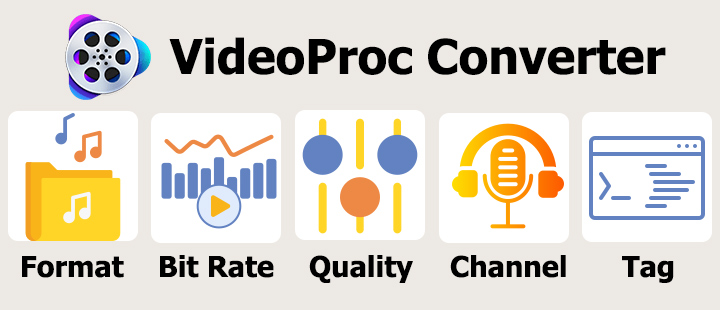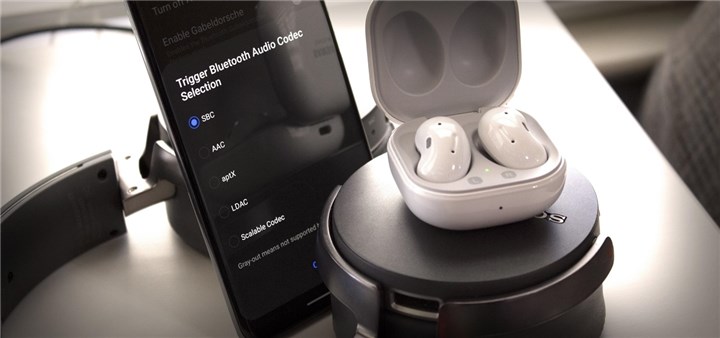Audio codecs play a crucial role in shaping our multimedia experiences, from the music we stream to the podcasts we consume. They are essential for reducing file sizes and streamlining data transmission without sacrificing quality.
AAC codec (Advanced Audio Coding) is a standard for lossy digital audio compression. It offers a remarkable step up in sound quality and efficiency from its predecessor, the MP3 format. From Apple iTunes and YouTube to broadcast TV and radio, AAC's presence is widespread.
When it comes to Bluetooth audio codec, the AAC codec brings better sound quality with minimal bandwidth usage. It is supported across many platforms, including Android and iOS, making it a versatile option for audio streaming.
What Is the AAC Codec
Advanced Audio Coding (AAC) is more than just a digital audio compression format. It represents a sophisticated leap forward in audio codec technology, designed to achieve superior sound quality over its predecessors like MP3 at similar or even lower bit rates.
It was developed by the Moving Picture Experts Group (MPEG), involving collaboration among several key technology companies, including Fraunhofer IIS, Dolby Laboratories, AT&T, and Sony. The codec was officially introduced in 1997 as part of the MPEG-2 standard and was later included as part of MPEG-4.

1. Technical Specifications
- AAC codec bitrate: AAC is versatile in its bit rate support, capable of handling anywhere from 8 kbps to over 320 kbps. This flexibility allows it to adapt to various bandwidth and storage requirements while maintaining audio quality.
- Sample Rates: It supports a wide range of sample rates, from 8 kHz suitable for voice to 96 kHz suitable for high-resolution audio, which caters to a broad spectrum of audio applications.
- Audio Quality: Due to its efficient encoding algorithms, AAC provides high-quality audio at lower bit rates. It uses tools like Temporal Noise Shaping (TNS) and Perceptual Noise Substitution (PNS) to enhance sound quality.
2. Profiles Within the AAC Family
- AAC-LC codec (Low Complexity): The most widely used profile, optimized for a good balance of complexity and audio quality.
- HE-AAC (High Efficiency): Combines AAC-LC with Spectral Band Replication (SBR) to provide better performance at low bit rates, ideal for streaming applications.
- HE-AAC v2: Adds Parametric Stereo to HE-AAC, further enhancing efficiency at low bit rates with stereo content.
- AAC-LD (Low Delay): Optimized for applications requiring low latency, such as real-time communication.
3. Standardization
As a part of both the MPEG-2 and MPEG-4 standards, AAC is not just a format but a framework that has been extended and refined over the years to adapt to the changing needs of digital audio consumption, ensuring compatibility and performance across a vast range of media platforms and devices.
AAC Bluetooth Codec in Audio Streaming
When you stream audio over Bluetooth, the codec—compression/decompression—plays a crucial role. This tiny engine ensures that your music is packaged neatly and sent over the airwaves from your device to your headphones or speaker. Among the various codecs available, Advanced Audio Coding (AAC) has become a prominent player in the Bluetooth audio space.
AAC codec is favored for its ability to compress high-quality audio without a significant loss in sound fidelity. If you're an Apple devices user, you'll find AAC is the Bluetooth audio codec that your devices default to. This preference arises because AAC is a cornerstone of the A2DP profile, which stands for Advanced Audio Distribution Profile. This profile defines how high-quality audio can be streamed from one device to another over a Bluetooth connection.
Why should you care about AAC in Bluetooth audio streaming? Here are several key reasons:
- High Compression Efficiency: AAC is renowned for maintaining high audio quality even at lower bit rates. This makes it ideal for Bluetooth streaming, where bandwidth can sometimes be restricted. AAC achieves this through more sophisticated encoding algorithms that preserve important audio details more effectively than codecs like SBC.
- Enhanced Audio Experience: One of the standout features of AAC is its ability to provide a consistent audio experience across different devices. This is especially true within the Apple ecosystem, where AAC is extensively optimized. This uniformity ensures that users experience minimal variation in sound quality when switching between devices, from iPhones to Macs to iPads.
- Power Efficiency: AAC's efficient encoding not only conserves bandwidth but also helps in reducing the power consumption of devices during Bluetooth audio playback. This is crucial for devices like wireless earbuds and portable speakers, where battery life is a significant consideration.
- Improved Synchronization: While not as low-latency as some dedicated codecs like aptX Low Latency, AAC still provides adequate synchronization for most general listening and streaming needs, making it suitable for watching videos and playing casual games without noticeable audio delay issues.
Within the Bluetooth technology ecosystem, the right codec can make or break your listening experience. AAC has carved its niche in this ecosystem by balancing efficiency with quality, ensuring that you enjoy your music to the fullest, wirelessly.
Advantages of AAC Bluetooth Codec
AAC codec (Advanced Audio Coding) is known for its high compression efficiency, which allows for superior audio quality transmission over Bluetooth. Unlike older codecs like SBC (Subband Coding), AAC uses more complex algorithms to preserve sound fidelity despite compression. This results in a listening experience that can more accurately reproduce the nuances of the original recording.

When you compare AAC with other codecs like SBC and aptX, AAC stands out, particularly in ecosystems associated with Apple devices. While SBC is the universal standard and offers decent quality, AAC generally achieves better sound quality at similar bit rates, due to its more advanced encoding techniques.
AAC codec latency is competitive within its category, offering a balance between sound quality and synchronization. This differs from aptX which offers lower latency but is not as widely supported across all devices. Meanwhile, LDAC caters to high-resolution audio support, but its advantages are more noticeable when there's no restriction in the bandwidth.
| Codec | Audio Quality | Latency | Compatibility |
|---|---|---|---|
SBC |
Standard |
Moderate |
Universal |
AAC |
High |
Moderate |
High (esp. Apple devices) |
aptX |
High |
Low |
Limited |
LDAC |
Highest |
Variable |
Limited |
Lastly, AAC's compatibility is its strong suit; it's readily supported on a wide range of devices, particularly iOS and macOS devices, making it an ideal choice for users within the Apple ecosystem. You'll benefit from AAC without needing any special hardware.
The Low Complexity Communication Codec (LC3) is a newer codec intended to eventually replace SBC. While not as widely adopted yet, it promises even higher efficiency and performance. AAC remains the preferred option for those wanting to balance quality and compatibility today.
AAC vs MP3
AAC (Advanced Audio Coding) and MP3 (MPEG-1 Audio Layer 3) are two of the most prevalent lossy codecs you'll encounter. Each has its advantages and use cases, impacting your listening experience.
AAC is the result of international efforts to create a superior audio codec. It generally offers better sound quality than MP3 at the same bitrate, which means you get a more efficient encoding and a smaller file size with preserved audio fidelity. AAC is the default codec for Apple products, and it provides support for multichannel audio and higher resolution audio, adapting to the complexities of modern audio needs.
MP3, on the other hand, is a bit of an audio compression veteran and widely supported across all devices and software. MP3's compression works well for a variety of music genres, but its algorithm is older, which can mean a slight sacrifice in sound quality at lower bitrates compared to AAC.
Let's take a closer look at the differences between AAC and MP3 in a direct comparison:
| Feature | AAC | MP3 |
|---|---|---|
Audio Quality |
Superior at the same or lower bit rates due to more efficient encoding algorithms. |
Generally requires higher bit rates to achieve comparable audio quality to AAC. |
Efficiency |
More efficient in terms of compression, providing better sound quality at lower bit rates. |
Less efficient, with larger file sizes needed for high-quality audio. |
Latency |
Generally offers acceptable latency for streaming but not as low as some dedicated low-latency codecs. |
Similar latency to AAC, suitable for general audio playback but not ideal for real-time applications. |
Hardware and Software Support |
Widely supported across all modern devices, with particular optimization in Apple devices. |
Universal support across all devices and software, often used as a standard audio format. |
Licensing and Patents |
Requires licensing under the MPEG group, though fees are generally low. |
No longer encumbered by patents, making it freely usable without licensing fees. |
Typical Use Cases |
Preferred for streaming applications and devices where high quality is crucial at lower bandwidths. |
Used broadly for digital audio files where compatibility and file size are key considerations. |
AAC on Different Platforms
AAC (Advanced Audio Coding) enjoys broad support across major operating systems, each integrating this versatile codec in unique ways to enhance digital audio experiences.
- AAC audio codec Windows: Windows provides native support for AAC through its media frameworks like Windows Media Player and through the Universal Windows Platform (UWP) for developers. This allows seamless playback and integration in applications.
- AAC audio codec macOS and iOS: Apple has been a strong proponent of the AAC format, using it extensively across its ecosystems. macOS and iOS support AAC out of the box, not just for playback but also for encoding and streaming. This deep integration is evident in the use of AAC for iTunes music files, Apple Music streaming, and even system sounds.
- AAC codec Android: Android also supports AAC playback and streaming. Since Android is based on a Linux kernel and supports a wide range of audio applications, AAC is commonly supported by most devices and applications on this platform. Android developers can easily implement AAC encoding and decoding using Android's built-in media APIs.
- AAC codec for Linux: Unlike other operating systems, Linux does not include native AAC support due to licensing restrictions and patent concerns. However, users can add AAC support through third-party software like VLC or through GStreamer multimedia framework.
Despite differences in native support and optimization, AAC codec remains highly compatible across all platforms, ensuring files can be easily shared and played back on different devices without issues.
Challenges and Limitations
While the Advanced Audio Coding (AAC) codec offers numerous advantages, like any technology, it also faces certain challenges and limitations that can impact its effectiveness in some scenarios.
1. Power Consumption
Although AAC is efficient in terms of compression and can save bandwidth, its encoding and decoding processes can be more power-intensive compared to simpler codecs like SBC. This can lead to higher battery consumption in mobile devices, which is a critical consideration for users and manufacturers.
2. Latency Issues
AAC is not the best fit for applications requiring ultra-low latency, such as real-time audio monitoring or gaming. In such cases, codecs like aptX Low Latency or others specifically designed for low latency might be more appropriate. Watching movies or playing video games? You might spot the lip-sync issues quite easily.
3. Sound Quality
AAC's performance is highly dependent on the bitrate. While it's designed to deliver High-fidelity audio, when bitrate is constrained – which happens in certain Bluetooth applications – sound quality may suffer, especially if your audio gear is of a high standard.
4. Licensing and Cost
Unlike MP3, which no longer has patent restrictions, AAC still requires manufacturers to pay licensing fees. This can increase the cost of devices or software that use AAC, potentially making it less attractive for some applications or markets.
5. Device Compatibility
While AAC is widely supported, not all devices implement it in the same way. Your experience with AAC may vary significantly depending on the hardware and software involved in the audio chain.
Conclusion
AAC codec (Advanced Audio Coding) plays a crucial role in the digital audio ecosystem. It's known for its efficiency in compressing digital audio without a substantial loss in quality. Its longevity is attributed to its adoption by a broad range of software and hardware, making it increasingly important for your audio experience.
If you are experiencing audio codec unsupported issues or looking to convert AAC to MP3 or other more widely supported formats, VideoProc Converter AI offers a robust solution. It integrates a simple interface and many 1-click presets, making it an excellent choice for those unfamiliar with complex settings. And power users can still benefit from the customizable settings to get their desired quality. The support for batch conversion will save you lots of time and energy when dealing with multiple AAC files. Furthermore, VideoProc Converter AI includes an AI Noise Suppression tool to help intelligently remove background noise for a more immersive auditory experience.
Hesitate no more to download and try VideoProc Converter AI.









